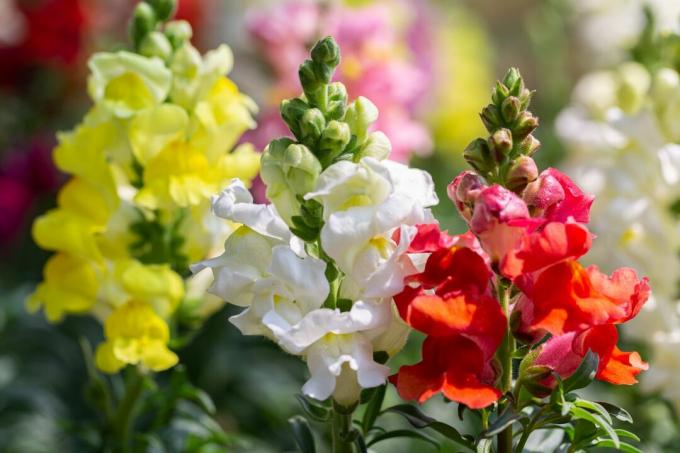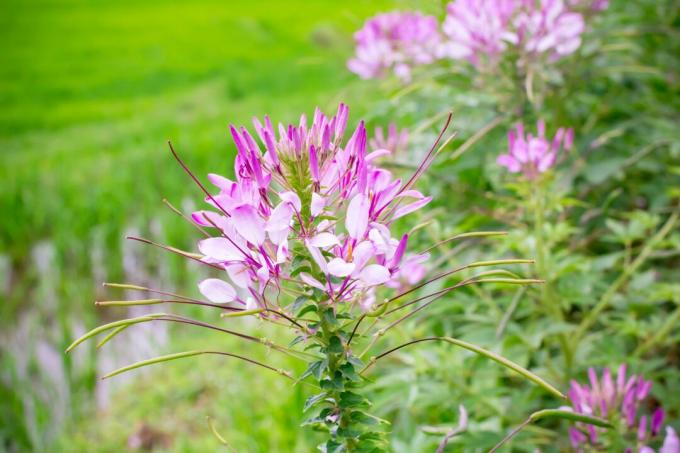In autumn, colorful foliage and numerous autumn flowers bring color to the garden. But which flowers bloom in autumn? We present 10 species that bloom until the first frost.

Autumn is characterized by a wide variety of colours: the colorful leaves of shrubs and trees in particular are eye-catchers in the gardens. However, various flowers still show their colors during this time and provide important food for insects. Below you will find 10 beautiful autumn flowers for the balcony and garden.
contents
- 1. foxtail
- 2. snapdragons
- 3. dahlias
- 4. zinnias
- 5. cosmea
- 6. marigold
- 7. Purslane florets
- 8. cornflower
- 9. sunflower
- 10. spider flower
1. foxtail
The annual foxtail (amaranth) can grow up to 170 cm high on deep soil. The sprawling plants are particularly striking in autumn with their thick, colorful panicles of flowers, which are reminiscent of a bushy foxtail. They can stand upright or hang depending on the species. The inflorescences, which are up to 60 cm long, or the entire plant can be dried and used as a long-lasting decoration in dried bouquets. The flowers are particularly eye-catching in autumn, as they have eye-catching colors such as burgundy, orange, bronze or yellow-green. Foxtail seeds are edible and, like quinoa (
Chenopodium quinoa) prepare. the plume (Celosia) is incidentally a relative of the foxtail, although its seeds are not eaten. The foxtail does not make any special demands on the soil: it can grow on all normal garden soils and does not require any care.
2. snapdragons
The snapdragons (antirrhinum) is a perennial flowering plant that delights with its large, colorful flowers from June to October. In mild winters, the snapdragon is even perennial, but in severe frosts and colder winters it is usually an annual. The numerous seeds of the snapdragon ensure plenty of offspring and it is always exciting to see which color combinations appear in the offspring. The snapdragons are usually 30 to 50 cm high and have white, yellow, orange, red, pink or purple flowers. Mixed colored flowers are not uncommon. They are mainly visited by bumblebees, because the closed flowers only open for heavy insects and release their mouths with nectar. Snapdragons are undemanding and do not require special care. If faded flowers are cut out regularly, new flowering shoots will form again and again.

3. dahlias
With the numerous, varied species and varieties, the dahlia (dahlias) probably one of the most form-rich garden flowers. When it comes to dahlias, there is almost nothing that does not exist. Their white, yellow, orange, pink, violet or red colored, simple or double to capitate, round or pointed petals: the variety of shapes and colors is simply overwhelming. In the garden, the colorful plants bloom from June until the first frost and not only enchant autumn. Unfortunately, dahlias are not hardy: after the first frost, the above-ground, faded parts of the plant should be cut back to about 6 cm and the tubers should be dug up. These are then overwintered in the house or winter quarters in a dark, cool and frost-free place. More tips about Overwintering Dahlias can be found in our special article.

4. zinnias
Although they are zinnias (zinnia) not as well known as many other autumn flowers - but their appearance is in no way inferior to them. Zinnias come in a wide variety of colors. With their flat to rounded flower shape, they resemble ball dahlias or chrysanthemums (chrysanthemum). The zinnia is therefore an absolute must for colorful gardens. But the sun-loving plant also cuts a good figure in other ways: from July to October, the beautiful flowers bloom in all their splendor and beautify every garden. It is particularly suitable as a cut flower, which encourages it to bloom again. The zinnia is also very easy to care for and can be grown without any problems. It just doesn't tolerate waterlogging, but it gets along well with dryness. Unfortunately, the zinnia is not hardy and has to be sown every year to beautify the garden.

5. cosmea
Also known as a jewelry basket (Cosmos bipinnatus) well-known, annual cosmos grows into a graceful, fine-leaved plant between 100 and 120 cm tall. The sowing of the light germinator takes place between April and May, the cosmos blooms between July and September. The fall flowers form cup-shaped daisies with a yellow center of numerous, elongated tubular florets and a corona of large, flat, variegated ray florets. They can be colored in different shades of white, pink or red. The cosmos flower is a popular cut flower. Cutting encourages the frost-sensitive plant to branch and form new flower buds. The cosmos is an important fall bloomer for bees as it provides nectar and pollen for pollinating insects well into October. Therefore, it is also in numerous flowering mixtures, such as in ours Plantura bee pasture, contain. The more than 20 different plant species ensure that suitable flowers thrive in almost all locations and that many bee-friendly flowers provide food until the first frost.

Plantura bee pasture
Over 20 annual & perennial species for
Bees, bumblebees & co, easier to care for
Blossom dream in bed, pot & window box
6. marigold
the marigold (tagetes) is a long-flowering plant. Thanks to its compact growth, it is also suitable as an autumn bloomer for balconies and terraces. Depending on the type and variety, the marigolds start flowering as early as June or as late as autumn. The foliage of the marigold often smells lemony and aromatic on contact. Holding marigolds in one mixed culture harmful roundworms (nematodes) and its edible flowers can be used in cooking. The different shades of yellow, orange and red go perfectly with the fiery colored autumn leaves. Marigolds do not make any special demands on the soil and are particularly beginner-friendly autumn bloomers.

7. Purslane florets
The Purslane florets (Portulaca grandiflora) is an attractive flowering plant with small, thickened, water-storing leaves and colorful flowers. The flat to creeping plants can also be planted in tubs as balcony flowers. They form numerous 3 to 4 cm large, colorful flowers between June and October. The purslane rosettes, which come from South America, love full sun, hot and dry locations. Our annual plants are grown on the windowsill from March and planted out in May. Purslane rosettes form simple to double flowers in a wide variety of color nuances and are therefore versatile autumn bloomers.

8. cornflower
The annual cornflower (Centaurea cyanus) is a field border wildflower. Along with poppy (Papaver rhoeas) it forms the typical splash of color at the edge of a grain field. The heady, frayed flowers with their long tubular flowers are typical. They are colored blue, red, pink or white and attract numerous pollinators. The cornflower is not a perennial. Therefore, it must be sown again every year unless it self-seeds. The approximately 30 cm high plants can easily be planted on the balcony. They prefer a sunny location on loose, well-drained and slightly calcareous soil. Although cornflowers appear as typical summer flowers, their flowering period extends into October. If the faded flowers are cut out regularly, new buds will form.

9. sunflower
Anyone who already misses the long sunshine from the summer can simply get a little sun in the garden. the sunflower (Helianthus annuus) is one of the best-known flowers with its typical yellow to red ray florets and brown center. Depending on the variety, sunflowers usually reach a height of 100 to over 300 cm. Dwarf sunflowers, on the other hand, with a growth height of between 30 and 60 cm, are ideal as autumn flowers for tubs and planters on the balcony and terrace. It thrives in full sun in all normal, well drained, nutrient-rich garden soils. It flowers from June to October. But the sunflower doesn't just cut a fine figure in the garden: sunflowers are also in great demand as starting material for decorations. In September, the delicious sunflower seeds can be harvested, which taste great as muesli, bread, but also as a snack for in between. Alternatively, grain-eating birds use the nutritious seeds and quickly devour the daisy flower.

10. spider flower
One of the most extraordinary and elegant autumn flowers for the garden is the spider flower (Cleome). The flower, which is actually perennial, comes from South America and is only cultivated here once a year because it cannot withstand the cold. The 50 to 150 cm high ornamental plants bloom between June and October. The name of the spider flower comes from the numerous, long stamens of the flowers, which protrude outwards and are reminiscent of spider legs. The delicate flowers are clustered together in terminal clusters and shine in various shades of red, violet and pink or white. The spider flower prefers full sun locations as well as permeable and nutrient-rich soil.

Hardy autumn bloomers enchant anew every year with their late flowering and autumn colors. We provide them most beautiful autumn perennials and their demands on the location.
...and receive concentrated plant knowledge and inspiration directly in your e-mail inbox every Sunday!
